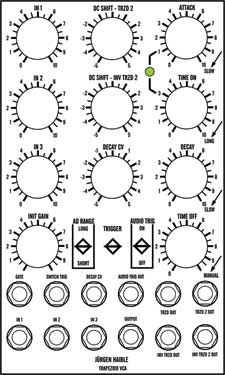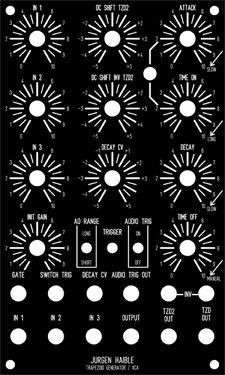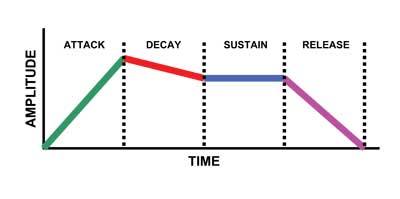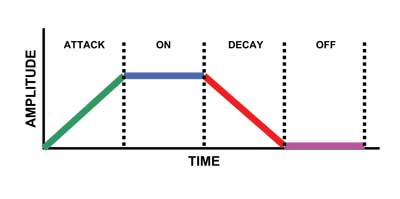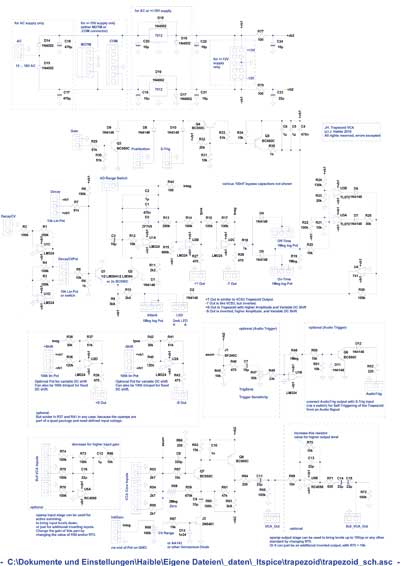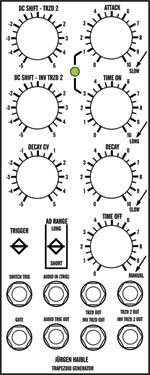Bill and Will's Synth
|
Table of Contents |
|
Here's a table of contents that we hope will make this page easier to traverse: Background - presents an explanation and Jurgen's initial description of the module Construction/Feature Options - presents different possible implementations Parts - presents a Bill of Materials and notes about it Panel - presents our ideas for a MOTM style panel Construction Phase 1 - Resistors, Capacitors, IC Sockets, Power Plugs, MTA headers Construction Phase 2 - Trimmers - OK, this is where we've left off for now |
Background
|
|
Jurgen lists the Module's features like this: "Trapezoid VCA"
What's a Trapezoid Generator?The Trapezoid Generator is similar to an Envelope Generator but has three "on" stages. An Envelope Generator (EG) like the MOTM-800, has four "on" stages; Attack, Decay, Sustain, and Release. The "contour" parameters will be self-evident for anyone who has a modern synth, but to us, with my background of prior ownership of a Synthi-AKS, it wasn't until we read Paul's user guide that we realized what the parameters meant. These EGs always wait to be triggered by an external Gate or Trigger. Wikipedia's great article on synthesizers outlines it like this: "The contour of an ADSR envelope is specified using four parameters:
So - the EMS "Trapezoid Generator" (TG) has three "on" stages: Attack, On, and Decay. But there's a fourth parameter for "Off" time. Just like on the Synthi, this is controlled by an "OFF" knob, and like on the Synthi, turning this knob fully clockwise makes it wait for an external, "Manual," trigger like typical EGs. Turning the OFF knob to the left of extreme clockwise, controls an "auto repeat" function - the further it's counterclockwise, the less time it stays off - or the faster it starts its Attack / On / Decay contour again. On the Electro-music forum, member "BananaPlug" attempted a full description thus:
Jurgen replied: "This is probably how a theoretical Trapezoid generator would work. <Smile> "The EMS (and mine also) is more quirky. For instance, the ON-Time begins before the Attack Time is fully completet, so the two always depend on each other. I never made an attempt to describe all these little specialities in words. You "feel" them when you turn the knobs and change the parameters, and the whole thing reacts in a pleasant, yet not entirely expected way." So What's an FET-based VCA?Well - an FET is a field-effect transistor... an OTA is an operational transconductance amplifier... but how does a VCA based on FETs differ from those based on OTAs - and what is the sonic difference? Jurgen wrote: "I'd say *if* the signal level is high enough for that FET VCA to colour the sound, it will colour it very differently than an OTA, or other classic VCAs. "The closest device I can think of, to that EMS VCA, is the UREI 1178 compressor. - Yes, I think that nails it. A poor man's 1178 modified as VCA." Schematic Diagram:
|
Construction / Feature Options |
Option Details |
Parts |
|
Will and I have developed a parts-list / bill-of-materials in the form of an XL spreadsheet. Jürgen has been very patient and helpful answering our pesky questions. As of today, 9 December, 2010, it's almost complete. Corrections to BOM: None yet - Notes: None yet - Click here to download the spreadsheet (apx. 350K). |
Panel |
|
We came up with these designs and desided on the one with the VCA Input Attenuators (in the middle).
here's our FPE design
|
Construction Phase 1All the stuff in Phase 1 gets soldered using "Organic" Solder. At every break in the action, we wash the board off to get rid of the flux. |
Construction Phase 2All the stuff in Phase 2 gets soldered using "No-Clean" Solder and the PCB doesn't get washed off from here on. |
Set up / Testing |
Use Notes |
|
|
|
The fine Print: Use this site at your own risk. We are self-proclaimed idiots and any use of this site and any materials presented herein should be taken with a grain of Kosher salt. If the info is useful - more's the better. Bill and Will © 2005-2011 all frilling rights reserved
|
